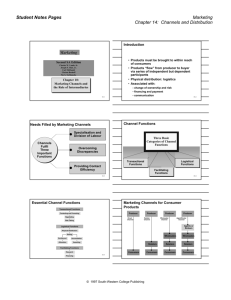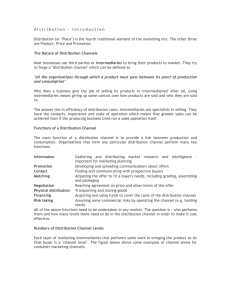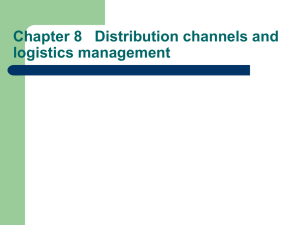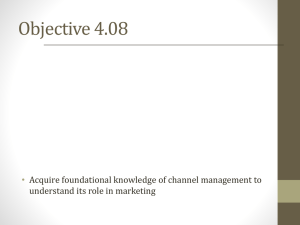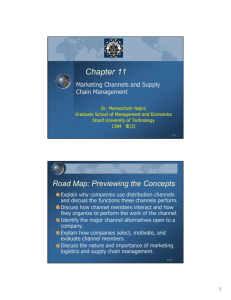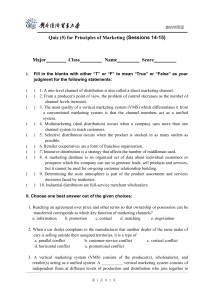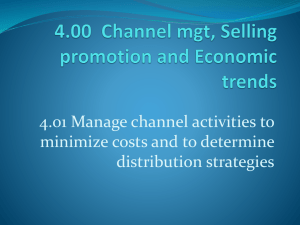Week 2: Physical Distribution & International Marketing Channels
advertisement
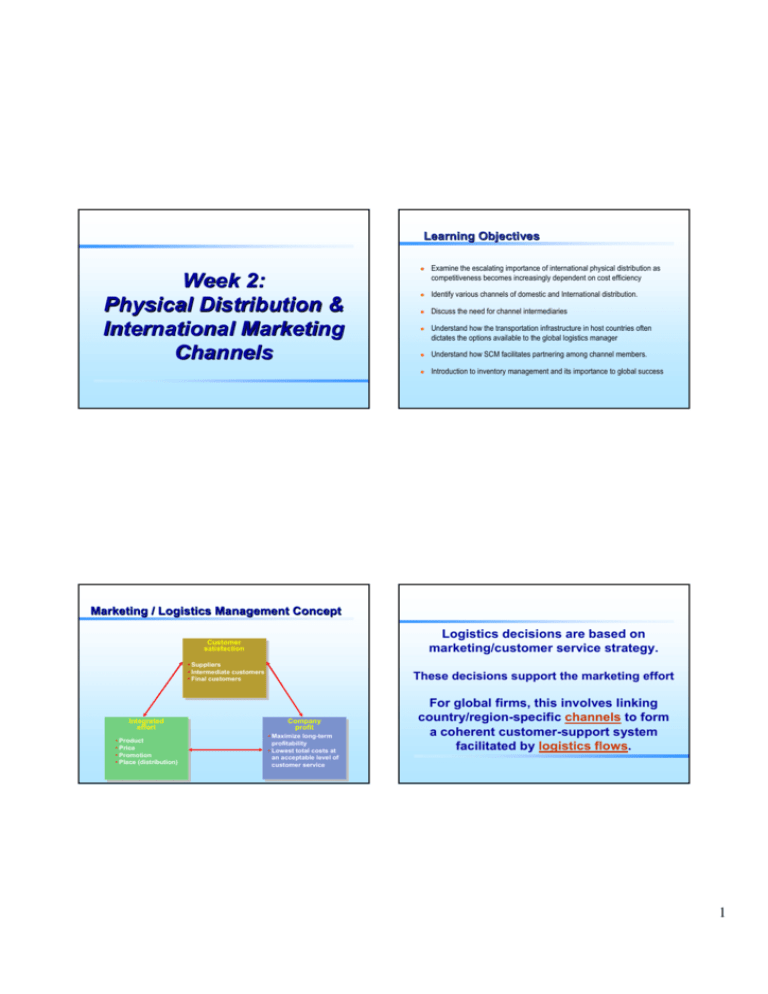
Learning Objectives z Week 2: Physical Distribution & International Marketing Channels Examine the escalating importance of international physical distribution as competitiveness becomes increasingly dependent on cost efficiency z Identify various channels of domestic and International distribution. z Discuss the need for channel intermediaries z Understand how the transportation infrastructure in host countries often dictates the options available to the global logistics manager z Understand how SCM facilitates partnering among channel members. z Introduction to inventory management and its importance to global success Marketing / Logistics Management Concept Customer satisfaction Logistics decisions are based on marketing/customer service strategy. • Suppliers • Intermediate customers • Final customers These decisions support the marketing effort Integrated effort Company profit • Product • Price • Promotion • Place (distribution) • Maximize long-term profitability • Lowest total costs at an acceptable level of customer service For global firms, this involves linking country/region-specific channels to form a coherent customer-support system facilitated by logistics flows. 1 Logistics Involves Both... Channels of Distribution Definitions z Internal interactions between product groups, departments and divisions z z A sequence of marketing organizations that directs a product from the producer to the ultimate (or end) user. Systems of relationships among businesses that participate in the process of buying and selling products and services May sometimes be referred to as a supply chain or marketing channel Multiple Channels for Consumer Products z External interactions with customers, suppliers and third party providers Manufacturers/Suppliers use different channels to reach different market segments Formal (contract-based) vs. Informal (Partnerships) Channel Relationships Channel Structure z Determined by the functions specific organizations perform. Affects: • Control over performance of functions • Speed of delivery and communication • Cost of operations Definition: International Physical Distribution z Designing and managing of a system that controls the flow of materials into, through, and out of the international corporation. z Encompasses the total movement concept by covering entire range of operations concerned with product movement, including both exports and imports simultaneously. z z This ‘system’ concept of logistics: Based on notion that materials-flow activities within and outside firms are so complex and can only be considered in the context of their interaction. Total cost vs. Total after-tax profits (takes into account impact of national tax policies) The Physical Distribution System Domestic/Import Sourcing Corporate Physical Distribution Management Inbound Materials Through flow Domestic/Export Marketing Outbound Materials Supplier Order Processing Transportation Inventory Management Customer Order Processing Inbound Materials Management Outbound Distribution Management Domestic Storage Foreign Storage Transportation Customer Service Inventory Management 2 Different Channel Flows z z z z Channel Flows Products/Service Ownership Promotional Information Supply Information There are channels for the flow of information There are channels for the flow of product/service There are forward channels There are reverse channels Producer Agent Wholesaler Retailer Consumer Money Market research Information Demand Information Products/Service (returns) Middleman (or marketing intermediary) z An organization that links producers and users within the channel. – Merchant middleman—takes title to products by buying them, e.g. retailer, distributor, wholesaler, etc. – Functional middleman—helps in the transfer of ownership of products but does not take title to the products, e.g., 3pls. Efficiency Provided by an Intermediary The services of intermediaries reduce the number of contacts, or exchanges, between producers and buyers, thereby increasing efficiency; especially across longer distances. These intermediaries however ‘lengthen’ the supply chain. Producer Buyer Producer Producer Buyer Producer Buyer Buyer Middleman or intermediary Producer Buyer Producer Buyer Producer Buyer Producer Buyer Source: William M. Pride and O. C. Ferrell, Marketing: Concepts and Strategies, 2000e. Copyright © 2000 by Houghton Mifflin Company, Adapted with permission. Figure 15.3 3 Why Channels Develop z Intermediaries evolve in the process of exchange because they can increase the efficiency of the process by creating time, place, and possession utility z Intermediaries enable the adjustment of the discrepancy of assortment by performing the functions of sorting and assorting z Marketing agencies form channel arrangements to make transactions routine z “Power” Power” in the Channel z Each channel member has strengths and weaknesses z The channel member with the greater power (known as the “Channel Captain”) will dictate roles within the channel or even develop alternative channels z What’s wrong with this picture? Channels facilitate the searching process by consumers Vendor Managed Inventories (VMI) z Instead of worrying about inbound freight and ordering optimal quantities, why not have the vendor manage a pocket of inventory close to our manufacturing location z Or, have vendor manage the inventory in our DC or stores z Illustration: Multiple Vendor Managed Inventories (MVMI) at Ryder Integrated Logistics z Exploits the VMI concept by offering a consolidated approach and value-added services Matching SupplySupply-Chains with Products Functional Innovative Products Products Efficient SC - ‘Lean’ Match Mismatch Mismatch Match Responsive SC - ‘Agile’ 4 Postponement and Speculation Postponement and Speculation Postponement – Moving differentiation closer to the consumer – Can result in shifting risk and uncertainty within the channel – Can reduce channel costs by: • Postponing changes in the form and identity of a product to the last possible point in the marketing process Speculation – Channel member assumes risk rather than shifting it – Reduces costs through: • Economies of large-scale production • Placement of large orders that reduce the costs of order processing and transportation • Reduction of stockouts and their associated costs • Reduction of uncertainty • Postponing inventory location to the last possible point in time since risk and uncertainty costs increase as the product becomes more differentiated. Channel Separation z Occurs when ownership does not directly flow with product, i.e., physical flow of goods (logistics channel) is separate from ownership (transaction channel) z Results in improved performance z Requirements: – Fast, reliable transportation system – On-line interactive order processing system – Swift, efficient information flows Bucklin’ Bucklin’s Theory of Channel Structure z Purpose of channel is to provide consumers with the desired combination of its outputs at minimal costs z Best channel forms when no other group of institutions generates more profits or consumer satisfaction per dollar of product cost z Conclusion: Functions will be shifted from one channel member to another in order to achieve the most efficient and effective channel structure 5 Channel Structure • Most distribution channels are loosely structured networks of vertically aligned firms. • The specific structure depends to a large extent on the nature of the product and the firm’s target market. • There is no “best” channel structure for all organizations producing or purchasing similar products. Distribution Channels Manufacturer Farmer Service Non-profit Organization Organization Broker Wholesaler Industrial User E-Commerce: Restructuring Distribution Channels Retailer Consumers Domestic vs. Global Channels z z z z z z z z z z Country-specific logistics requirements Complexity Costs Distances Intermediaries Alternative channel structures Time Control Information Decentralized decision making 6 Channel Optimization Alternative International Channel Structures Involves Decomposing SC Costs & Determining the Most Efficient Total Replenishment Path Suppliers Manufacturer International Division Host Country Buying Office Wholesaler Wholesaler Trading Company /Agent Trading Company /Agent Manufacturers Wholesaler Parent Company Distribution Centers Trading Company /Agent Wholesaler Distributor Wholesaler Distributors/ Retailers Distributor Wholesaler Wholesaler Wholesaler Customers Wholesaler Retailer Wholesaler Retailer Retailer Retailer Retailer Customer Designing Effective Channels - I • • • • • Traditional Channels No Integration Large Inventories No Information Exchange Limited Mfg. Flexibility • • • • • Channel Variability • Direct Shipments Heavy Integration • Value Added Services Low Inventories Information Sharing Flexible Mfg./JIT Designing Effective Channels - II Management must consider environmental (external) & marketing (internal) factors to structure effective channels External (Environmental) Issues z z z z Firms’ global presence → Increased distance, channel complexity, market diversity and cost Internal (Marketing) Issues z Types of Distribution Strategies – Intensive → Wide channels e.g., commodities – Exclusive → Narrow channels e.g., cars – Selective → Mixed & targeted e.g., soft-drinks z Product Characteristics: Value, Technical/Knowledge requirements, etc. z Customer Service Objectives: Product availability, Return policy, Delivery times and schedules, etc. Government Regulatory Environment: Trade Initiatives; Deregulation/Privatization; etc. → Need for flexible channel systems Corporate Reconfiguration → ‘Fluid’ Channel Structure: Vertical & Horizontal Mergers, Acquisitions & Integration Growth in, and use of, technological innovations to establish competitive advantage over other channels 7 Characteristics of Effective Channels z Flexible, Adaptable & Dynamic z Formal or Informal but Integrated Relationships z Global Management of, (+ Foreign Participation in,) region-specific distribution strategies z “No boundaries” z From Channel → Network z “Slim” (No excesses): Elimination of non-value adding activities z Channel leader optimizing overall efficiency Discussion – Home Work z z Discuss the ways in which channels change as countries evolve from emerging to established markets. How do channels in Japan differ from those found in Eastern Europe? Future Trends in Channel Structures z Supply Chain Management: Integrating inbound and outbound flows and cross-functional processes z QR & ECR: Increases value to customers. Facilitates ‘faster’ channel flows. ‘Shortens’ channel z Strategic Alliances & Partnerships: Transcending firms’ boundaries to achieve channel goals z Third-party Arrangements: Outsourcing functional responsibilities to external specialists QR: Typically implemented between manufacturers & retailers. ECR includes: Continuous replenishment; Flow-through distribution; Cooperative relationships between channel members; Use of POS data obtained by more accurate use of bar coding; facilitated by EDI Types of Channels z Ownership channel (title) z Negotiations channel (buy/sell) z Financing channel (payment) z Promotions channel (marketing) z Logistics channel (movement/storage) 8 Logistics Channel Functions z Concentration (Accumulating) – Combine multiple small shipments into larger shipments – Accumulating from different sources (consolidating) z Customization (Sorting out) – A shipment of different pieces is assembled – Sorting heterogeneous products into homogeneous stocks z Dispersion (Allocation) – Large shipments are broken down into smaller shipments – Allocating into smaller lots (bulk-breaking) z Assorting – Building assortments of goods for use or sale in association with each other 9
